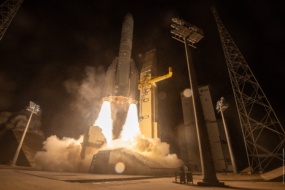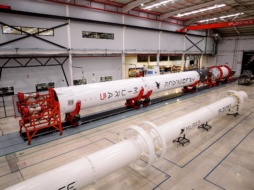COLORADO SPRINGS, CO—Norway is preparing to launch two satellites this summer to boost comms in the Arctic amid increasing tension in the region between NATO allies and Russia, the head of the Norwegian Space Agency told Payload.
Arctic comms: The nation’s Arctic Satellite Broadband Mission is aiming to provide better connectivity in a region plagued by communications problems and a lack of satellites orbiting overhead. The program, which will launch from Vandenberg in July or August, will also host payloads from the Norwegian military, Inmarsat, and the US Space Force, according to Christian Hauglie-Hanssen, director general of the Norwegian Space Agency.
The high north: The White House’s National Strategy for the Arctic Region, released in 2022, is very clear: “Russia’s war in Ukraine has raised geopolitical tensions in the Arctic.” Hauglie-Hanssen said Norway has long needed better connectivity and visibility into the Arctic waters that surround its borders, but that Moscow’s invasion has made the need even more urgent.
“We were seeing, even before the horrible Russian invasion of Ukraine, the escalation of the political attention towards the security issues and the dialogue that we’re having with the European Union and with our allies,” he said. “Then this war came, and it has really accelerated how we look at things.”
Hauglie-Hanssen also spoke with Payload about Norway’s Andøya spaceport, international cooperation in orbit, and the domestic space industry.
This transcript has been edited for length and clarity.
What information are you hoping to bring back to Norway from Space Symposium?
We are a small space nation, but we are fairly well coordinated. We have the upcoming big event, which is the launch from Andøya. We hope and think that we can be the first to actually launch off European soil into orbit. We’re joining forces with Isar Aerospace of Germany to launch up to more than one metric ton to polar orbit. That’s a big deal.
We’re trying to sort of wave our flag a little bit saying, “Hey, we are a reliable partner.”
Are you courting other international launchers to launch out of Andøya?
I think it depends on how the market develops. We are cooperating with Isar because they are a fast runner. They’ve been very good at attracting capital, so they’re well financed. But there are other competitors in Europe, and we will work with them. I think we’re pretty agnostic.
The original intent from the government was to make this as a purely commercial operation. At the same time, obviously, it’s also a strategic capacity. So the discussion going on now with other nations’ armed forces, and also the US, is how can this be exploited. In terms of rapid response and rapid launch? Those things are more operational from a military perspective.
What are other upcoming milestones for the agency?
Norway is launching the first two satellites that will cover and provide broadband services in the Arctic. It’s very exciting. Space Norway, which is a government owned entity, has developed this program. But the interesting thing is, it’s a three party program, where the Norwegian armed forces have their payload, Inmarsat has their payload, and we are working jointly with the US Space Force, so they also have a payload.
This is a new capability in Europe. I think it’s kind of elegant, how we’re looking at this as both civil and military. It definitely saves money and time. It will be launched from Vandenberg in late July or early August.
How does Norway cooperate in orbit with international partners, including the US?
From the civilian side, ESA is our home base—22 European nations working on developing world class programs. Also, we’re now developing a national program. We have just last year established the Arctic surveillance program, which is a joint civil military program headed by the agency, where we’re working with a coastal authority and the armed forces for providing and developing compute capability for maritime monitoring.
I really think that is a very, very powerful vector for Norwegian space policy, in that once we have proven that we are able to establish these programs, we are working systematically, that gives us a leveraging position towards other nations. When we want to cooperate with the US or with European nations, we want to contribute actively. We’re not just knocking at the door and asking for services. We will be an active provider or contributor.
Is Russian activity driving your effort to have better visibility in the Arctic?
Definitely, yes. But historically, we are a maritime nation, so placing this capability into orbit is just an extension of what we’ve been doing for centuries.
We need to overlook our waters. We have coastal-based AIS systems, and we have a Coast Guard and maritime fleet, but this is a very efficient way of extending that need into other capacities, like space-based services.
We were seeing, even before the horrible Russian invasion of Ukraine, the escalation of the political attention towards the security issues and the dialogue that we’re having with the European Union and with our allies. Then this war came, and it has really accelerated how we look at things.
What are the specialties of the Norwegian space industrial base?
We have a fairly small industrial base, and it’s niche oriented, trying to draw from experience in other markets. In most nations, companies dealing with space have some kind of relation to defense a lot of the time, and it’s the same thing in Norway.
We are more of an equipment provider than the prime. And again, drawing the line to the Arctic Surveillance there, the political ambition there and the task to my agency is how to develop a national prime. So there’ve been some interesting acquisitions where Kongsberg Defense Aerospace acquired NanoAvionics and they now have an industrial base for providing microsatellites
We have the ground services, which are very mature by KSAT. We have KDA, which has been operating under ESA programs since the early 90s. And then we’re seeing how this can be developed into more system level architecture capacity to develop our market position.
Regarding startups, it is difficult. You need to have some substantial amount of risk money to feed into smaller startups. We have a growing cubesat environment at the university level, so they have launched a small handful of cubesats.
The thing that is easy to communicate from Norway is that we do have this very explicit need for space capacities: being in the Arctic, having ocean borders, being high north, and being sparsely populated.




